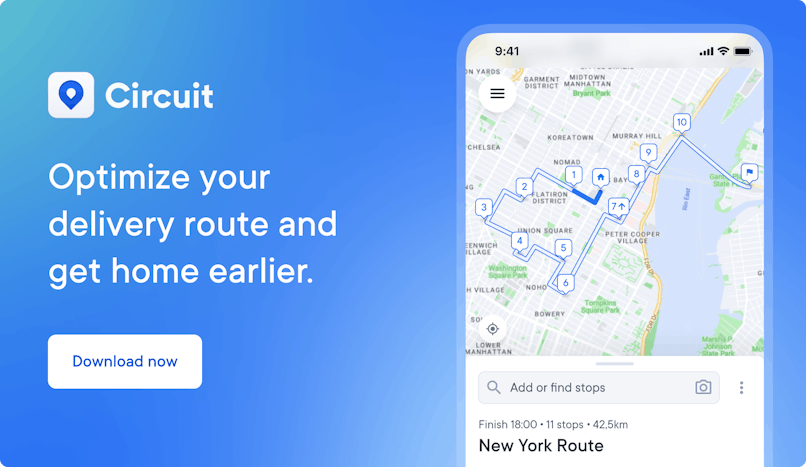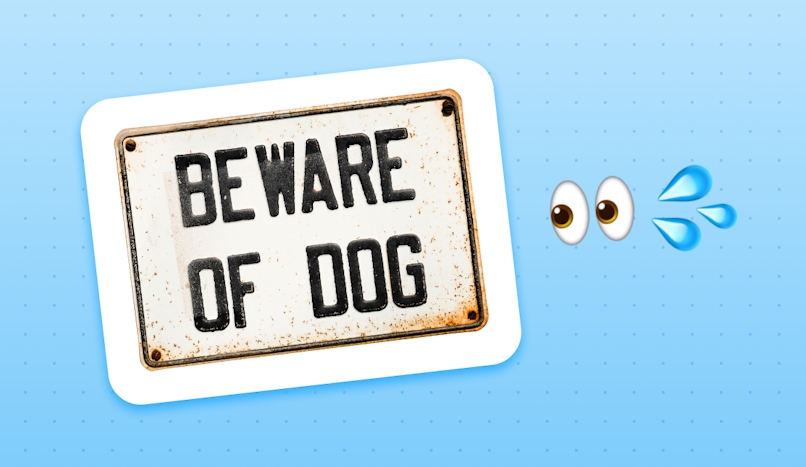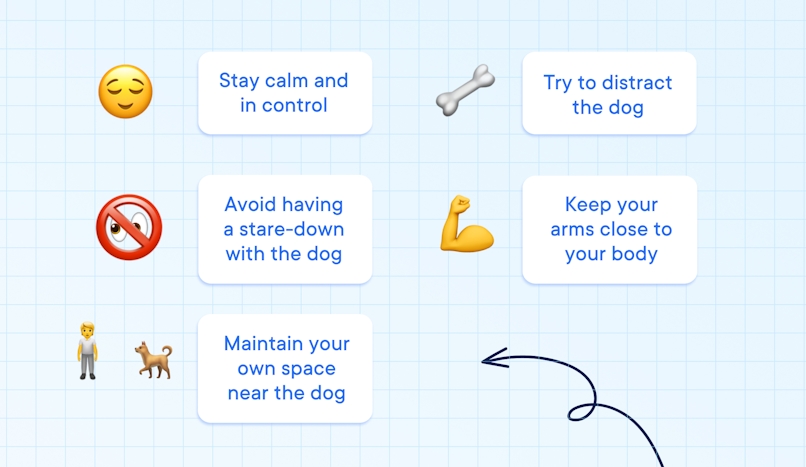How to Deal With Aggressive Dogs on Your Route
Delivery drivers can avoid dog attacks and still complete deliveries successfully using these helpful tips on dealing with aggressive dogs.

Do you want an app that optimizes your delivery routes and reminds you when a stop has a dog around? Check out Circuit Route Planner.
When you’re minding your business making a delivery, and someone’s furry best friend starts giving you the business, what do you do?
Run? Freeze? Drop down and play possum?
Unfortunately, delivery drivers often have to deal with dogs that get loose and attack.
In June 2022, the US Postal Service (USPS) released its dog attack national rankings as part of National Dog Bite Awareness Week, reporting that there were 5,400 dog attacks on postal carriers in 2021.
Of course, USPS drivers aren’t the only delivery service people challenged by aggressive dog behavior.
In June 2022, an Amazon delivery driver ended up in the hospital after being attacked by a dog in Southern California.
And in December last year, an Instacart delivery driver was bitten in Georgia.
These are just a couple of recent stories that happened to make the news.
The real-life consequences when dogs attack delivery drivers can include both financial and physical costs.
I’m here to help with important tips on how you can avoid dog attacks while still completing your deliveries, and prevent any dog from ruining your career as a delivery driver.

The importance of avoiding dog attacks
If you’re bitten or otherwise injured by a dog while working as a delivery driver, you could face financial losses — not to mention any physical harm you experience.
It’s important to avoid getting hurt by aggressive animals to prevent some of these issues:
- Time off the job spent in recovery, or worse, long-term disability
- Lost earnings and customers due to interrupted time on the job
- Medical expenses, with or without health insurance or worker’s comp
- Higher stress levels, which cause health issues and reduced productivity
- Legal expenses required to file suit against the dog’s owner
Taking all of those aspects into consideration, the financial burden of dealing with dog attack injuries can add up fast. Protect yourself by reading the rest of this guide on how to keep yourself out of a dog fight.
Why do dogs bite delivery drivers?
There are a few common situations when delivery drivers risk getting bitten by dogs:
- Opening a gate or door to leave a package closer and finding an angry dog
- Handing off a package at the front door and a dog accidentally gets out
- Meeting an unleashed dog while working outside the delivery vehicle
But why would a dog bite you just because it has the opportunity?
The answer has to do with why a dog becomes aggressive toward anyone in the first place.
Although many people focus on avoiding bigger, traditionally aggressive dogs like pit bulls, even small dogs can become aggressive.
In a helpful guide published by VCA Animal Hospitals, two board-certified veterinarian doctors explain the different types of dog aggression:
- Fear aggression (dog feels the need to defend itself)
- Territorial/protective (guarding the home and family)
- Conflict/status-related (proving dominance)
- Possessive (guarding food or toys)
- Maternal (guarding pups or the nesting area)
- Play (pups growling/nipping, mostly harmless)
- Redirected aggression (learned strategy to change a situation)
- Pain-induced (reaction to injury)
- Pathophysiological/medical (caused by a condition like rabies)
- Learned aggression (taught aggressive behavior or abused)
In many cases, dogs show more than one form of aggression.

Signs of canine aggression to watch for
First, be on the lookout for any new dogs when making deliveries. Common signs that a home may have a dog around include “Beware of Dog” warning signs, dogs or bowls on the porch, or an outdoor dog kennel.
Then, any time you see signs of a dog — either loose on the street or at your next delivery stop — look and see if the dog seems anxious or aggressive.
Body language says a lot about a dog’s state of mind — the same way human body language often displays our own feelings.
If you pay attention to a dog’s body language and its actual vocal language, you might be able to nip a potential problem in the bud.
Signs of anxiety or fear in dogs include:
- Yawning or blinking
- Lip licking or panting
- Turning away
- Avoiding eye contact
- Flattened ears
- Crouching/lowering the head
- Tucking tail under body
- Sudden, rigid stillness
- Lying down with legs up
Signs of aggression include:
- Fixed, intense stare
- Ears standing up stiff
- Fur raised on back/tail
- Tail raised high
- Growling, snarling, barking
- Showing teeth
- Lunging forward/charging
- Muzzle punching
- Snapping, biting, shaking
The normal sequence of aggression in dogs is best represented by the popular Canine Ladder of Aggression, which starts at the bottom with yawning, blinking, and licking, and ends at the top with biting.
However, one study makes an important distinction between “normal” dogs and “ill” dogs:
“If a dog growls, snarls, and lunges systematically at everyone approaching without first warning (barking and/or growling) and then pausing for a response, that aggressive behavior becomes inappropriate and out of context. That dog is ill (“abnormal”) and is unable to make the distinction between threat and non-threat.”
You’ll probably notice this type of dog right away since it’ll be ready to attack you the moment it sees you.
Great, right? Yeah, no.
That’s why we wrote the rest of this article. Keep reading to find out what to do when an aggressive dog sets its sights on you.
Whether you get that first warning from a normal dog and you have a chance to de-escalate the situation, or you’re facing down an ill and vicious attacker, use the tips below when a dog becomes a danger on your delivery route.
Note that barking dogs are not always aggressive
It’s important to remember that although aggression and fear can be the cause of a dog barking, it isn’t always.
Dogs bark for many different reasons.
My two Boxer puppies go outside every evening to bark along with the other neighborhood dogs. It’s … lovely.
Other than communicating with each other, dogs also bark:
- Just for fun
- To get their owner’s attention or because they want something
- As a happy greeting
- Out of excitement
- Due to boredom/loneliness
You can try to tell the meaning of a dog’s barking by paying attention to the pitch of the bark and how fast the dog is barking.
An aggressive bark will sound deeper in pitch, more guttural than a happy or lonely bark.
Dogs that are negatively aroused also bark with more barks in a row and in quicker succession than a happily barking dog.
No matter why you think a dog is barking, don’t react with fear or aggression yourself.
Avoid triggering any further aggressive behavior.
The next section goes into detail on how to avoid doing just that.
We’ll explain the five basic ways to avoid an attack when you meet an aggressive dog on your delivery route and what to do if a dog does go after you.

How to handle aggressive dogs on your delivery route
Let’s start with a few ground rules when it comes to dealing with strange dogs.
First of all, never approach a loose dog whatsoever.
If you see a loose dog hanging around outside, calmly walk away backward, facing the dog (no eye contact!).
Try not to draw attention to yourself. You’re a ghost. Shhhh.
Second, never assume that a dog is completely secured behind a gate or even a door. You don’t know how sturdy or well-closed it is.
The same goes for leashes, ropes, and chains — in fact, 25% of fatal dog attacks are by chained dogs.
Because how long is that chain? Is that rope tied tight enough to the post so that it won’t come loose when the dog gets really angry and motivated?
You just can’t tell.
Third, be cautious before opening any gate or door at a property where a dog could be kept.
Not only could a dog come out from where you didn’t see it, but by opening the area up, you’ll also make yourself at fault for any attack that might happen as a result.
While laws vary from state to state, if you’re attacked after entering a previously closed area where a dog was confined, you may not have a case for compensation against the owner.
Make sure you know what you’re doing any time you open someone else’s gate or door.
But when these precautions aren’t enough, and you find yourself face to face with an aggressive dog, remember the following five proven tips to protect yourself.
Stay calm and in control
If a dog actively shows aggression toward you, stay as calm as possible.
Do NOT run.
Do NOT shout.
You want the dog to understand that you aren’t a threat and that you’re not looking to respond to its aggression with aggression.
Back away slowly without turning your back to the dog. Pretend to ignore it as long as possible.
If the dog is loose and moves toward you, firmly yet quietly tell the dog “No!” or “Stay!”
Keep facing the dog until you can get inside your vehicle or to another safe place, such as the other side of the street.
Remember, you are the alpha in charge, and you’re not looking for a fight. Make sure the dog understands that.
Avoid having a stare-down with the dog
One sign that a dog is feeling aggressive is if it’s staring you down intensely.
Make sure not to look back.
If you make direct eye contact with a staring dog, the dog may take your stare as a challenge and escalate the situation.
You definitely don’t want that.
Instead, avert your eyes, looking anywhere but into the dog’s eyes.
You can also stand sideways to help the dog see you as less of a threat.
Even if you’re backing away and telling the dog “no,” be sure to look away from the dog’s eyes, avoiding that death stare at all costs.
Maintain your own space near the dog
Whether you’re on a porch or a sidewalk, you can limit a dog’s ability to attack you by “claiming your space.”
Set a package down in front of you, for example, to serve as a physical barrier between you and the dog. A backpack, jacket, bicycle, or garbage can will work, too, if you don’t have a package in hand.
By expanding your personal space like this, you’ll also help show the dog that you’re in charge by taking up more space and going about your business while ignoring them.
Try to distract the dog
Turning an angry or fearful dog into a happy, good dog is a great way to keep it from attacking you.
You can give the dog a treat or toy as a great distraction for accomplishing that.
Consider carrying a bag of dog treats with you on your route. A simple treat could mean the difference between a bite and a safely completed delivery.
Another way you might distract an angry dog is by throwing a water bottle, a backpack, or anything else to chew on that isn’t you.
Keep your arms close to your body
It’s important not to wave your arms or hands around when facing an aggressive dog — to avoid posing as an even bigger threat.
Instead, keep your arms close to you. Crossing your arms close to your chest can also help protect you in case a dog attacks.
Attacked? Pin the dog mouth away from you
Unfortunately, thousands of delivery drivers are attacked by dogs every year. Even if you do your best to avoid a dog fight, there’s always a chance you’ll still end up in one.
If a dog aggressively lunges at you, the best defense is to quickly grab the dog’s neck or head and pin it to the ground so that its mouth can’t bite you.
Use your weight to your advantage and hold the dog against the ground while you figure out your next steps.
This worked for me, my family, and our pups one day when we were out on a neighborhood walk, and an unleashed German Shepherd started running toward us.
My husband grabbed the dog by the neck and held it to the ground until the dog’s owner could catch up to us and take their dog.
We were so relieved that no one was hurt.
Sadly, people aren’t always that lucky.
I’ve been bitten in the past, and I know how it feels at the moment of the attack.
It’s really scary when a dog’s teeth latch on, and you’re at risk for a serious injury.
When a dog attacks and starts biting you:
- If the dog is snapping, make fists to protect your fingers.
- If the dog is latched on, do NOT pull away to prevent further injury.
- Push your bitten arm/hand into the dog’s mouth to choke the dog and prevent its teeth from tearing into you further.
- Pinch the dog’s sensitive nose to try making it let go.
- If you fall, curl into a ball to protect your face and body.
Pepper spray works too!
Once you regain control, pin the dog and look for help. As long as you can keep the dog’s mouth away from you, you can stop the attack from continuing.
When you’re finally safe — whether the dog calms down or runs off, the owner takes charge, or you’re able to get to a safe space — make sure to treat any wounds and also document the incident.
Notify the police if you’re seriously attacked and injured. You might be entitled to compensation.
Stay safe on your route with these tips
If there’s no way for you to safely deliver a package because a dog is threatening you, keep yourself out of harm’s way.
A delivery is not worth your life.
When any USPS mail carrier is confronted by an aggressive dog, they can skip the delivery and require the customer to pick up their package from a local post office.
In May 2022, the USPS was so concerned about the frequency of dog attacks on their postal carriers in an Indiana neighborhood that mail delivery to the neighborhood was temporarily suspended until the dog owners could get control of their aggressive dogs.
Take care of yourself with the same concern.
And that’s where Circuit Route Planner can help.
The route optimization tool not only gives you the fastest routes for your delivery schedule but also lets you record notes for delivery addresses.
This note feature is helpful to drivers who need to create reminders about dogs at specific stops.
The first time you meet a new dog, you can make a note in Circuit to remind yourself, for example, not to open the front gate at the house because a dog is inside the yard and to leave packages outside the gate.
With these notes, you can help yourself stay safer around any dogs you regularly visit and save time by completing these riskier deliveries faster, according to what you’ve already learned.




